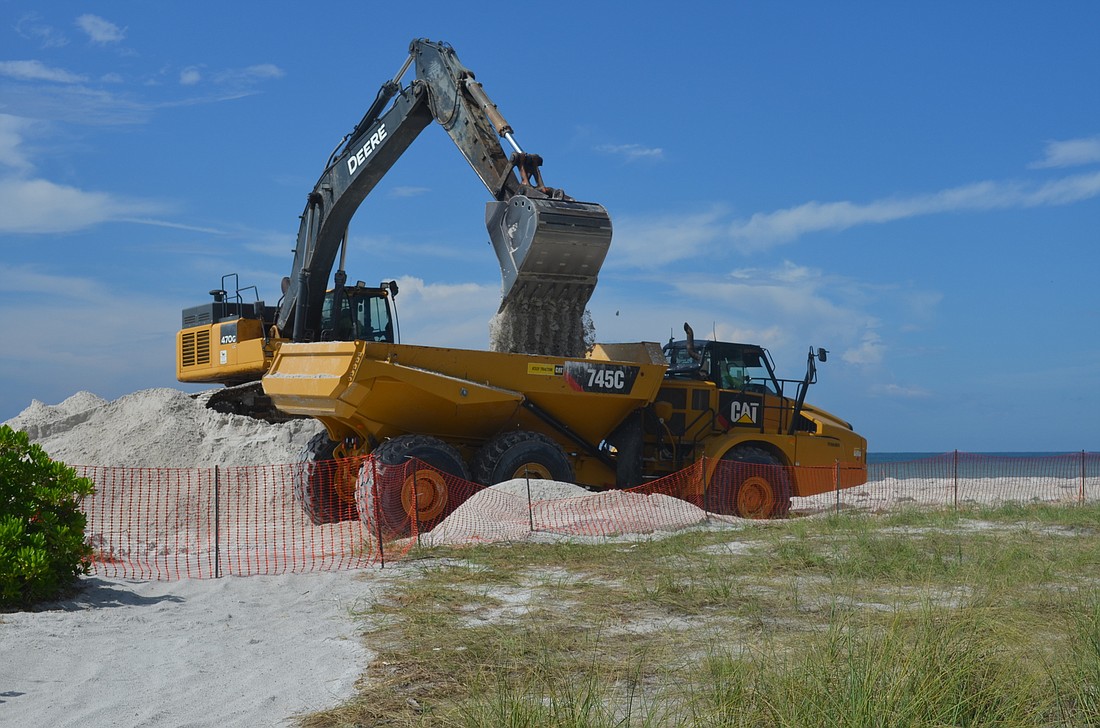- July 26, 2024
-
-
Loading

Loading

Longboat Key needs more than 60,000 cubic yards of sand to replace what was lost on portions of its beach to erosion last September during Hurricane Irma, a survey of the island’s shoreline shows.
But, because other portions of beach gained sand in the storm, the Federal Emergency Management Agency this week denied the town’s request for help.
A survey of the town’s beaches, the report of which was completed July 6 by Olsen Associates, a Jacksonville coastal engineering company, showed that the island lost 61,700 cubic yards of sand on four of eight gulf-facing segments when the storm swept up the peninsula the weekend of Sept. 9-10, 2017.
A segment facing Longboat Pass also lost sand but doesn’t qualify for reimbursement.
The same survey found four other gulf-facing segments gained more sand than was lost, adding more than 137,000 cubic yards. The net gain across 10.1 miles of shoreline was about 61,000 cubic yards, the survey found, which swayed the FEMA decision.
The surplus of sand doesn’t negate the need for work to reset the shoreline to its pre-storm condition, said Al Browder, a coastal engineer with Olsen Associates.
The town plans to appeal the methodology FEMA used to reject its request, said James Linkogle, the town’s Public Works project manager.
“Our first response is, ‘OK, fine, that’s your look at it. But we’ll probably get Al [Browder, coastal engineer] and Isaac [Brownman, Public Works director] on the phone and ask if you could be more succinct and definitive,’” Linkogle said.
While it would seem practical to move the surplus sand to nearby areas that lost sand, Browder said it’s not that simple. The sand gained and lost is often underwater, and hiring a dredge for such operations wouldn’t make financial sense, he said.
Browder said the gains and losses blur the lines of the engineered beach as designed in large-scale renourishment projects, such as the one completed in 2016. That hastens the need for the coastline to be renourished to original specifications.
The uneven movement of sand in a storm is the result of out-of-the-ordinary forces.
“When the water level comes up, what happens is you’ve got waves rolling over that elevated water level that are now chewing on the dry, recreational beach area,” Browder said. “With sand moving along shore, it’s entirely possible that some of the sand from this could be in New Pass or Longboat Pass, or it could have accumulated in some places along the island.
“The beach does not erode in a uniform fashion.”
The lost sand accounts for about 9% of the total put on the island in 2016, when the town last nourished its beaches.
“It’s not a huge amount relative to, say, what we might place in a beach nourishment project,” Browder said of the lost sand.
The survey was a required step in seeking FEMA money for sand lost on an “engineered beach” as a result of a natural disaster. An engineered beach is one that has been nourished by state and local agencies for shoreline protection.
Longboat Key has been nourishing its beaches since 1993, when the town put more than 3.3 million cubic yards of sand along 9.3 miles of the island’s shoreline.
Reimbursement, if Longboat’s appeal is approved, is years away.
“It’s an arduous process, to say the least,” Linkogle said.
The town is just now nearing the end of the application and approval process for 17,600 cubic yards of sand lost in 2016 to Hurricane Hermine.
This story was updated Wed., July 18 at 10:18 a.m.